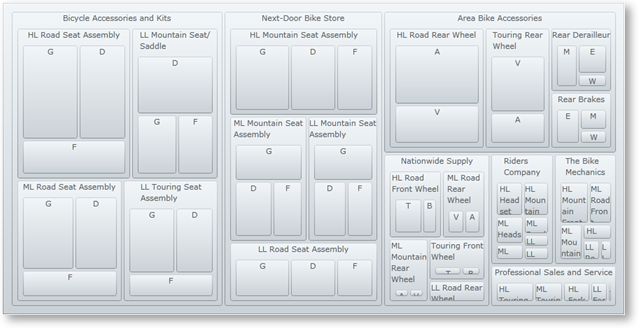
When binding to data, the xamTreemap™ control needs to understand the data. This is done with node binders.
The NodeBinder class has properties that indicate how the data should be read:
TextPath - determines the name of the property of the data source that contains text information.
ValuePath – determines the name of the property of the data source that contains the data.
TargetTypeName – determines the type of the data that is pointed by ValuePath.
ItemsSourcePath – if the data source is of hierarchical type, ItemsSourcePath is the name of the property that points to the child nodes.
NodeStyle – the nodes to which the NodeBinder binds will inherit the style specified by the NodeStyle property. Note that every NodeBinder can have a different NodeStyle.
We have the following classes: Manufacturer, Product and InventoryEntry. The Product class contains a List of InventoryEntry items, and the Manufacturer class contains a list of Product items.

We will now set the xamTreemap control to display the list of Manufacturer items from our data source.
The snippet shows three node binders – each binder applies to one of the classes (Manufacturer, Product and InventoryEntry).
In XAML:
<ig:xamTreemap.NodeBinders>
<ig:NodeBinder
TargetTypeName="Manufacturer"
ValuePath="Revenue"
TextPath="Name"
ItemsSourcePath="Products" />
<ig:NodeBinder
TargetTypeName="Product"
ValuePath="StandardCost"
TextPath="Name"
ItemsSourcePath="InventoryEntries" />
<ig:NodeBinder
TargetTypeName="InventoryEntry"
ValuePath="Quantity"
TextPath="Shelf" />
</ig:xamTreemap.NodeBinders>
